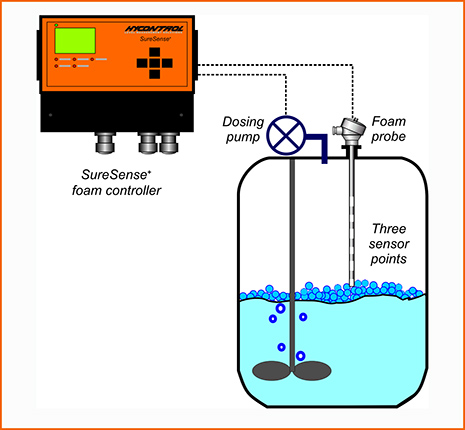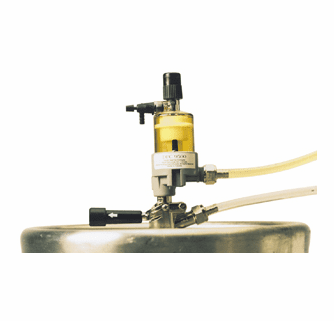Efficient Techniques for Accomplishing Ideal Foam Control in Chemical Production
Reliable foam control is an essential facet of chemical manufacturing that can substantially impact manufacturing effectiveness and product high quality. By comprehending the systems of foam formation and choosing proper anti-foaming agents, makers can take aggressive measures to alleviate too much foam.
Comprehending Foam Development

Surfactants, or surface-active representatives, lower the surface stress of the liquid, assisting in bubble stability and advertising foam generation. In addition, frustration or mixing processes can boost bubble formation, frequently intensifying foam problems. The qualities of the fluid tool, consisting of thickness and thickness, further impact foam habits; as an example, more thick liquids tend to trap air better, bring about raised foam stability.
Recognizing these fundamental facets of foam development is essential for effective foam control in chemical production. By identifying the conditions that promote foam advancement, producers can execute targeted strategies to mitigate its negative effects, thus optimizing manufacturing procedures and guaranteeing constant product high quality. This fundamental knowledge is important before exploring certain techniques for managing foam in industrial setups.
Choice of Anti-Foaming Agents
When picking anti-foaming representatives, it is important to consider the details characteristics of the chemical process and the kind of foam being produced (Foam Control). Different aspects affect the efficiency of an anti-foaming representative, including its chemical make-up, temperature security, and compatibility with various other procedure materials
Silicone-based anti-foams are extensively utilized due to their high efficiency and wide temperature level array. They function by minimizing surface area stress, enabling the foam bubbles to coalesce and break even more conveniently. They might not be ideal for all applications, particularly those including delicate solutions where silicone contamination is an issue.
On the other hand, non-silicone agents, such as mineral oils or organic compounds, can be useful in particular scenarios, specifically when silicone deposits are undesirable. These agents have a tendency to be much less efficient at greater temperatures yet can supply efficient foam control in various other problems.
Additionally, recognizing the foam's beginning-- whether it occurs from oygenation, agitation, or chain reactions-- overviews the choice process. Examining under actual operating conditions is important to ensure that the chosen anti-foaming agent meets the one-of-a-kind demands of the chemical production process effectively.
Refine Optimization Techniques
Reliable foam control is an essential element of optimizing chemical production processes. To improve performance and reduce production prices, producers must execute targeted procedure optimization techniques. One vital strategy includes readjusting mixing rates and setups. By fine-tuning these specifications, operators can minimize turbulence, consequently reducing foam formation during mixing.
Furthermore, managing temperature level and pressure within the system site can considerably influence foam generation. Reducing the temperature level might lower the volatility of specific elements, bring about reduced foam. Similarly, preserving optimal stress levels helps in minimizing extreme gas release, which adds to foam stability (Foam Control).
An additional reliable approach is the tactical enhancement of anti-foaming agents at critical points of the process. Cautious timing and dose can ensure that these representatives properly reduce foam without disrupting various other process criteria.
Moreover, incorporating an organized evaluation of resources properties can assist identify naturally frothing compounds, permitting preemptive procedures. Lastly, performing regular audits and process reviews can disclose inefficiencies and areas for renovation, allowing continuous optimization of foam control strategies.
Monitoring and Control Solution
Surveillance and control systems play a critical duty in preserving optimal foam management throughout the chemical production process. These systems are important for real-time monitoring and change of foam degrees, making sure that production effectiveness is made best use of while reducing disturbances brought on by excessive foam formation.
Advanced sensors and instrumentation are used to find foam density and elevation, supplying crucial data that notifies control formulas. This data-driven technique permits the prompt application of antifoaming representatives, ensuring that foam levels remain within acceptable limitations. By incorporating monitoring systems with procedure control software program, makers can execute automatic actions to foam fluctuations, lowering the demand for hand-operated intervention and boosting operational consistency.
Additionally, the assimilation of artificial intelligence and predictive analytics right into checking systems can promote positive foam administration. By analyzing historic foam information and operational specifications, these systems can forecast foam generation patterns and suggest preemptive procedures. Regular calibration and maintenance of tracking tools are important to make certain accuracy and dependability in foam detection.
Ultimately, effective monitoring and control systems are important for optimizing foam control, advertising security, and improving overall efficiency in chemical production settings.

Study and Finest Practices
Real-world applications of monitoring and control systems highlight the significance of foam monitoring in chemical manufacturing. A remarkable situation research includes a large-scale you could try here pharmaceutical maker that carried out an automated foam detection system. By incorporating real-time surveillance with anticipating analytics, the center decreased foam-related production downtime by 30%. The data-driven strategy permitted timely interventions, making certain constant product high quality and functional efficiency.
An additional excellent situation originates from a petrochemical business that adopted a combination of antifoam representatives and procedure optimization strategies. By analyzing foam generation patterns, the organization click this tailored its antifoam dose, resulting in a 25% reduction in chemical use and significant price savings. This targeted technique not just minimized foam disturbance yet additionally enhanced the overall security of the production process.

Conclusion
Finally, achieving optimum foam control in chemical production necessitates a thorough method incorporating the selection of ideal anti-foaming representatives, implementation of process optimization methods, and the combination of innovative tracking systems. Normal audits and training even more boost the performance of these methods, cultivating a society of continuous renovation. By resolving foam development proactively, producers can significantly improve manufacturing efficiency and item quality, ultimately adding to more economical and lasting procedures.
By comprehending the systems of foam development and choosing proper anti-foaming representatives, makers can take proactive actions to minimize excessive foam. The qualities of the liquid tool, including viscosity and density, further influence foam actions; for instance, even more viscous fluids often tend to trap air a lot more effectively, leading to increased foam security.
Understanding these essential aspects of foam development is vital for reliable foam control in chemical manufacturing. By evaluating historic foam data and functional parameters, these systems can anticipate foam generation patterns and advise preemptive procedures. Foam Control. Regular audits of foam control determines guarantee that processes stay maximized, while promoting a society of aggressive foam management can lead to sustainable improvements throughout the manufacturing spectrum